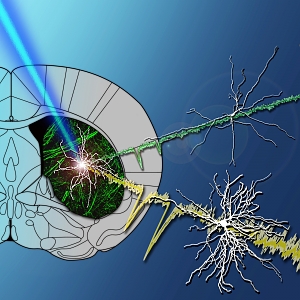Tommas Ellender, James Harwood, Polina Kosillo, Marco Capogna and Paul Bolam report in the latest issue of the Journal of Physiology (591: pages 257-272, 2013) for the first time the heterogeneous synaptic properties of the two main thalamic projections to the striatum which originate in the rostral central lateral (CL) and the caudal parafascicular (Pf) nucleus. Building on previous work of the Unit showing that the thalamostriatal neurons in these nuclei differ in their morphology, firing properties, as well as their striatal targets (Lacey et al. 2007), we set out to test the hypothesis that synapses formed in the striatum by neurons originating in either nucleus have different functional properties. To address this we isolated and selectively activated the thalamostriatal projections using targeted viral delivery of channelrhodopsin-2 (ChR2). Whole-cell patch-clamp recordings of neurochemically identified medium-spiny neurons (MSN) together with optical activation of specific thalamic inputs enabled us to identify the properties of the two types of thalamic synapse in the adult mouse striatum. We found that thalamostriatal synapses differ significantly in their peak amplitude responses, short-term dynamics, expression of ionotropic glutamate receptor subtypes and potential to exhibit spike timing-dependent plasticity. Our results reveal a hitherto unidentified heterogeneity in the thalamostriatal projection and suggest they subserve different roles in striatal function. More specifically they suggest that CL synapses may act as drivers of MSN spiking activity whereas Pf synapses may subserve the role of modulators of the activity of MSNs.
